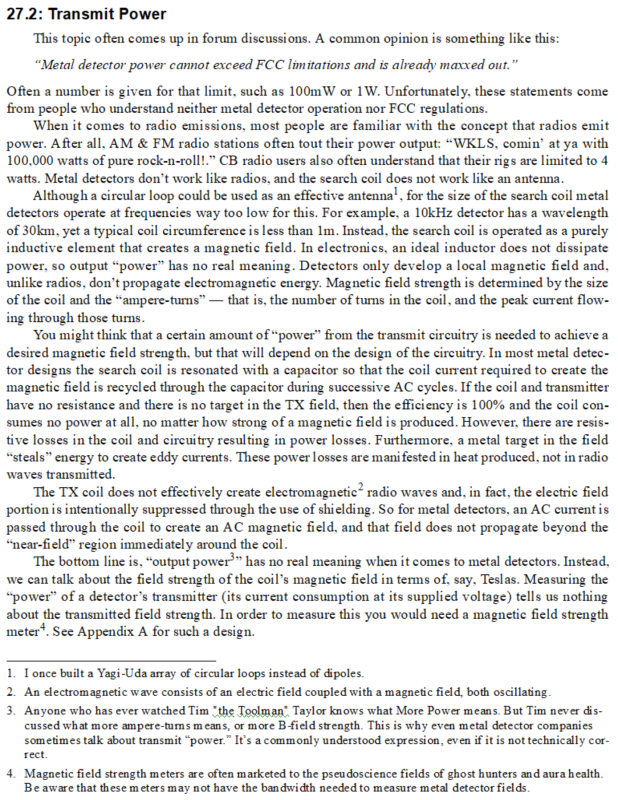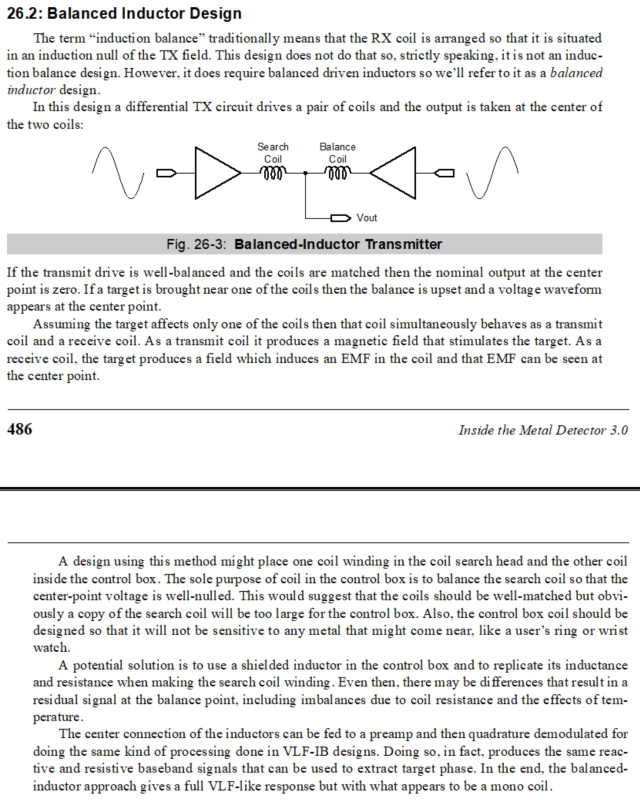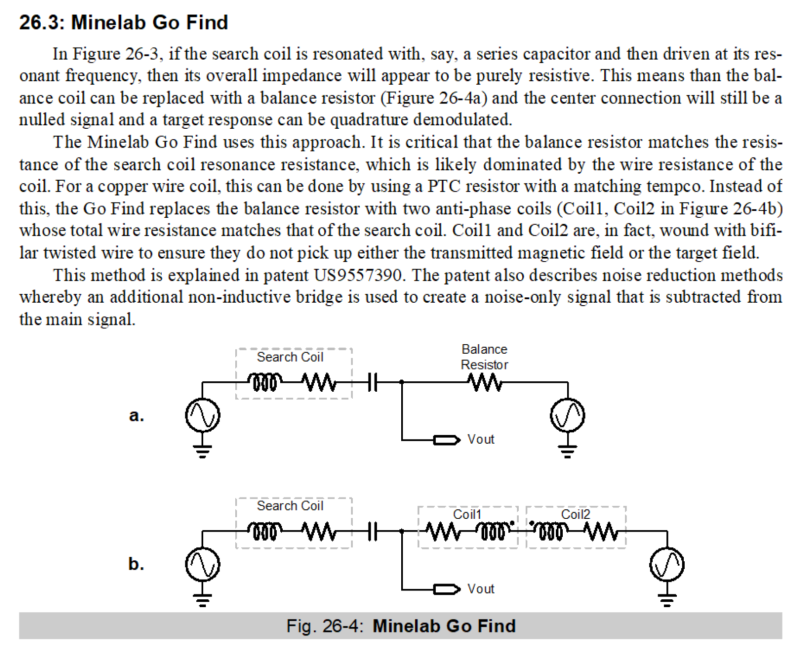-
Posts
584 -
Joined
-
Last visited
Content Type
Forums
Detector Prospector Home
Detector Database
Downloads
Posts posted by Geotech
-
-
7 hours ago, Guest WV CoinMiner said:
But it is not a myth of 5 watt regulation same as CB's.
While much of what you've posted has merit, this does not. Not even for CBs, which are limited to 4W. Here is an excerpt from ITMD-3:
ITMD also has a section that explains the actual FCC regs that apply to metal detectors but it spans 3 pages so I won't post it. But it explains the real emissions limits that detectors face, and that those limits are not a factor. If you want to know what they are, look up the FCC report for a recent detector (I think there was a thread here that talked about the Manticore) and it will specify every FCC reg that was applied. I've personally put several metal detectors through FCC testing so I know for certain what the requirements are.
-
-
-
Twisting a pair of wires does cancel external EMI, it also cancels the outgoing magnetic field. In this case the leads are a very tiny part of a large coil which is highly susceptible to EMI and also generates a large magnetic field, so I doubt whether the wires are twisted or not makes any difference whatsoever.
Induced EMI is proportional to the area-turns (area of the coil times the number of turns of wire) which likely favors the small coil.
-
His vector analyses are very much on the right track but some of his specifics are off. But a pretty decent job overall.
-
On 11/17/2023 at 12:19 PM, Mickey Mouse said:
I tried to replace all caps and now Cap # 31 on board 505- 0198-B exploder's every time I put one in.
Makes no sense. C31 is simply a cap directly across the battery. If it explodes then it's either backwards, (way) too low of a voltage rating, or the circuit is seriously screwed up.
On 11/17/2023 at 1:45 PM, Mickey Mouse said:I was re-checking the main board and found an IC chip U2, looks burned up. But cannot identify its numbers. I would appreciate if someone could identify, this chip number. (IC - U2) and post it to me.
U2 is a "4316" quad switch. Possibly a CD4316, but 74HC4316 and 74HCT4316 might also work. If this part is cooked, then you've got some super major problems.
-
I suggest you buy the most expensive long-range gold detector you can afford. In fact, buy the most expensive even if you can't afford it. Sell everything you own, mortgage the house, borrow money from family, friends, Vinny the loan shark. Then, when you find out the thing doesn't work, you'll have a painful education but one you'll never forget.
-
1 hour ago, Steve Herschbach said:
As one of those old timers let me clarify that. It is not so much depth that is limited but the ability to detect the target, which can be perceived as the same thing.
All true. What I was talking about was the problem of old analog discriminators. Where setting the discriminator to reject pull tabs might reduce the depth on silver quarters by half even though they are no where close to the disc cut-off. It was well-known back then that to maximize depth, turn the disc as low as possible.
Digital designs don't have that problem, but they do have the problem you bring up. Every disc or notch setting can have (and probably does have) a "brick wall" cut-off. With digital discrimination it's a none-or-all situation, unlike analog disc where it's a none-or-a-lot-less situation. With digital disc, a bad target right on the edge of the disc setting will get broken up, but so will a good target just on the other side of the edge.
Like you, I prefer to use no disc and listen to tones. I also prefer mixed-mode where I can hear the AM signal at the same time. Makes for busy audio but you get used to it, and I think it is actually easier to listen to than a bunch of broken up crackling made by a digital discriminator.
-
5 hours ago, iron_buzz said:
I have wondered it it would also be possible to apply that same logic to non-ferrous targets for detecting in places where you want to ignore shallow coins and pulltabs and such so you can focus on the deep targets.
This is called "surface blanking." It has been featured on a few detectors but I don't recall the specific models. Garrett did it years ago, and I think either Compass or Discovery as well.
-
6 hours ago, UKD2User said:
And magnitude of course (it's a vector, not scalar, quantity).
Yes, both magnitude and phase are calculated from the response vector, but only phase is used in disc and notch. Magnitude is used for the depth meter and audio loudness.
1 hour ago, iron_buzz said:For example, I hear a lot of people claiming that the higher you set your discrimination, the more you limit depth, but to me, as a retired computer programmer, I would assume that the discrim level you set is simply a parameter passed to a function.
That's one of those holdovers from the analog days. Those people are probably 60 or older. Back then, discrimination was set by rotating the demodulator phase until a given target started producing a negative response. It was then discriminated. Problem is, conductivities that were progressively closer to the disc point were progressively weakened. Newer designs do it digitally without altering any responses.
-
From the Better Late Than Never dept...
Neither Eric nor Bruce invented PI. Hard to nail it down to a particular person, here are some references Eric posted on Geotech:
1. 'On the Induction of Electric Currents in Cylindrical and Spherical Conductors' by Horace Lamb, 1884. 'a much simpler treatment' (than sine waves) 'that of the currents induced by the sudden cessation of a previously constant field'.
2. 'Apparatus for geophysical prospecting' (US Patent 2,278,506) 1942. TX pulse and RX switching by a motor driven camshaft which operated switches.
3. 'A Conducting Sphere in a Time Varying Magnetic Field'. J.R. Wait 1951. Both sine wave and step fields are covered.
4. 'A Method of Detecting a Mass of Non-Ferrous Metal Located at Depth in the Earth'. J.H. Wescott, 1955.
5. 'A Pulsed Bomb Locator'. F.B. Johnson 1956.
6. 'Method of Geophysical Prospection'. J.R. Wait (US Patent 2,735,980) 1956.
7. 'Eddy Current Method for Measuring the Resistivity of Metals' C.P. Bean et al. 1959. 'The measurement is made by noting the rate of decay of flux from a bar situated in an external magnetic field that has been rapidly reduced to zero'.
Eric was working on PI development in the 1960s at Oxford and wrote some journal articles of his own.
-
In the old days, the response of any target that was discriminated (whether using a linear disc or notch) was just blanked out. That is, if you were listening to a threshold audio, it would go silent over a disc'd target. In digital detectors, you can do whatever you want; make it grunt like a pig, or give it a Price-Is-Right "loser jingle."
The processing price of discrimination is negligible. A detector can reasonably resolve target phases to around 1°, and you could easily notch targets down to that resolution. That is, you could have 180 notch settings and control each one, even giving each one a different tone if you like. The White's V3 did this.
-
Internally, there is no difference. Notch is just a narrow band of discrimination, and all discrimination is based on target phase. And tone ID works the same way, where tones are assigned based on the phase response. With disc & notch, you just assign it "no tone at all" or, maybe, assign it a grunt sound.
-
12 hours ago, Digalicious said:
Around the same time, I discovered that SMF modes have a primary frequency. For example, the Legend's M1 primary frequency is around 15 khz. I would be in high EMI using M1 and the noise was intense, yet switching to the SF of 15 khz, caused most of the noise to disappear. That's when I realized that SMF is inherently more open to EMI than SF, despite SMF modes having a primary frequency. When I asked about that, an engineer either said it's because the frequencies and their associated EMI gets "accumulated", or he might have said "they get added together along with the EMI". I can't remember the exact term he used, but it was either "accumulated" or "added together". I'll try and find that post.
Metal detectors typically use "integration" as a way to improve SNR. It's basically averaging which is a form of accumulation. It can be done in analog or digital.
With MF there have been two broad approaches to processing the multiple frequencies. One way is to treat each frequency as a separate single frequency metal detector. That is, each frequency channel is individually ground balanced and individually gives a target response. The results from each channel can then be compared/correlated to determine what the target is. This is what the DFX & V3 do. We'll call this "channelized" processing.
Another way is to combine certain signals from each channel to create "composite" signals. One composite signal is typically the ground balance signal, another the salt balance signal, and target information is extracted from the composite signals. The Fisher CZ series uses this method, as do BBS/FBS. Composite processing tends to offer only a single VDI and a single graphable result, whereas with channelized processing you can get multiple graphs and multiple VDIs. This is why the V3 can give you all 3 spectrums.
With channelized processing you can treat each channel as a single narrow-band detector and tightly filter it. With composite processing, once the composite signals have been created they now have a blend of frequencies with noise mixed from different bands and you've got what you've got. It's possible that this is what is going on in the newer all-digital MF designs. It would be interesting to see if, say, a DFX or V3 struggle as much. However, another factor is that designs seem to continuously push up gain and sensitivity so maybe a DFX would be quieter but also not go nearly as deep.
3 hours ago, UKD2User said:I'd be fascinated to know how you know this, given the level of encryption protecting most embedded code in modern detectors - have you seen the source code or reverse-engineered one/several?
I design metal detectors for a living. No, I don't have any competitor's code but I can deduce some things from how the detector operates. I also look at competitor's patents which are often revealing.
-
On 10/23/2023 at 9:15 AM, Digalicious said:
About a year ago, I read a post in which a metal detecting engineer was explaining why SMF is so much more suspectable to EMI than SF. It went something like this:
With SMF, multiple samples (frequencies), get accumulated during the processing. Therefore, the EMI noise also gets accumulated accordingly.
...The difference in the channel frequencies is very small. Something on the order of a mere 0.02 khz difference between the channels. That's just too small of a shift to mitigate the various frequencies, harmonics, and random nature of EMI. Further to that, a frequency shift doesn't address the fundamental problem of noise when using SMF. That is, the exponential rise in noise due to SMF accumulating the EMI noise.
All single frequency, multifrequency, and PI designs use accumulation. No real difference there. The real difference is that a SF design is narrow band and MF and PI are wide band. A narrow band design allows you to more tightly filter the incoming signals which helps suppress EMI. Not only can you bandpass-filter the preamp, you can even bandpass-filter the RX coil. Can't do that with MF and PI, they have to run more or less wide open, although the preamp is usually lowpass-filtered at around 100kHz. That helps knock down radio interference.
Frequency shifting is really only effective for a single dominant EMI, and mostly for line noise (50/60 Hz). The problem is that the demodulators (part of the accumulators) can cause, say, 60Hz to "fold" into the baseband signal to where you can hear it. A slight frequency shift (maybe even a few Hz) causes this effect to become randomized so you no longer hear it. However, even though it's randomized it can still affect the detection and cause what's called "silent EMI."
-
In what way have the detectors failed?
-
Minelab has routinely removed part numbers in the past. Less so now.
The FET is an SI7464.
-
Yes, the charger normally gets warm, and if the battery is especially low the charger will get especially warm. For a battery that has been on the shelf for a year or more, I would closely monitor the charger to make sure it doesn't overheat.
-
Yes, "P" is fine. Means "Preset."
-
Correct, Chris officially "retired" from ICMJ, I think a year ago now.
-
"Signal Balance" is just a poorly chosen name for "Gain". Turn it up until the detector becomes unstable, then turn it down until you have good stability.
-
Also Todd Marshall at Centerville Electronics NW, he was head of the Service Dept at White's.
A fortunate thing with the TDI-SL is that it had a good reliability record. The biggest problem was that the 12" coil would develop a seam crack and leak water. If the camo version has the HiQ coil then that eliminates the main worry. These things are still selling on eBay for $600+ used so, say, $700 for the new one or $600 for the demo would be a good deal. If you don't like it, you can probably get all your money back. OTOH, the dealer probably has $800 in each one and may be reluctant to take a loss.
-
The short answer in 'no,' detectors are designed around the coil impedance characteristics.
The long answer is, it's possible but very difficult. First off, some coils are internally narrow-banded with a tuning cap and will only work with one frequency. DFX/MXT coil are not, they are wide-band so that's good. In most cases the TX coil inductance and resistance need to be fairly close so it may require winding an impedance-matching transformer. Depending on the detector design, the same may be needed on the RX coil (it would on the CZ). Even then, it will be difficult to get the phase response correct so disc will likely be off.
-
3 hours ago, PI-Man said:
Karl do you think there are any long term effects or potential failure of op amp by just shorting TP2 and TP31 even though so far machine running smooth? And any degradation of performance long term effects that you can think of by just doing the short without resistor — inadvertent loss of depth or any issues other than op amp abuse etc?
It should not make any performance difference. I know that Reg and some others have just shorted the cap and I have never heard of a failure. I'm just offering a word of warning.






Equinox 600 Vs Fisher F44 & F70
in Metal Detector Advice & Comparisons
Posted
See footnote #3. What ML probably means is that the Manticore has a 50% stronger TX field. I give ML a pass on this because what they are using is common terminology.